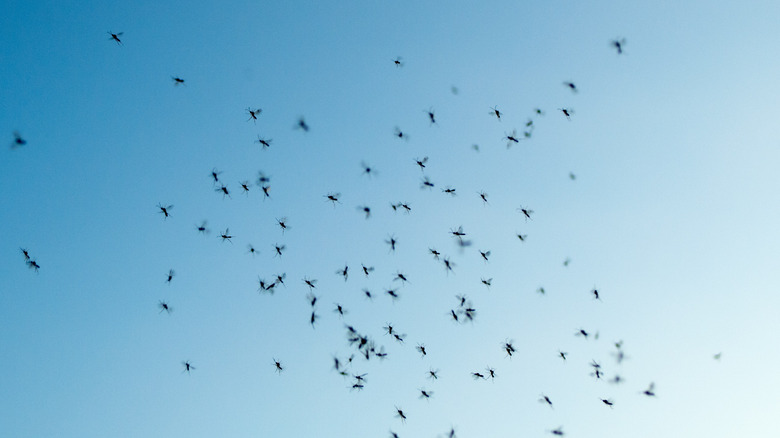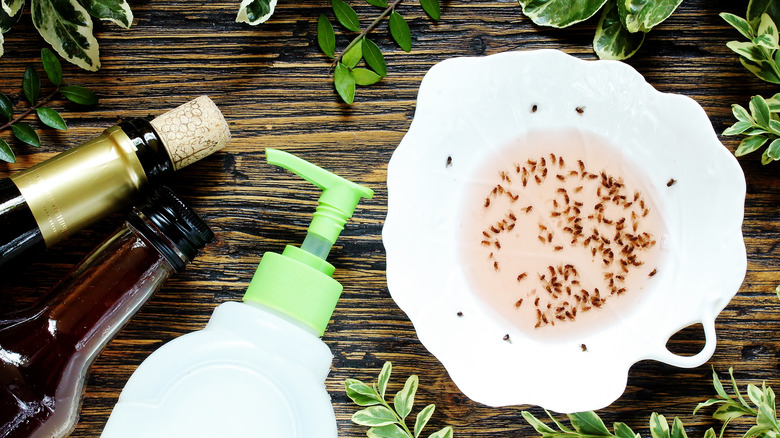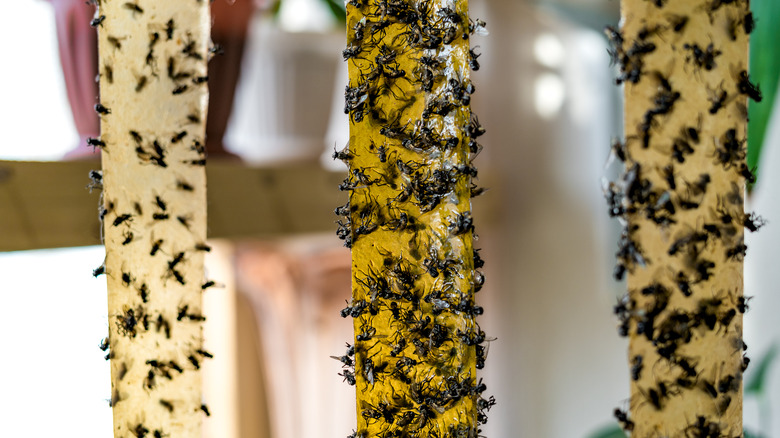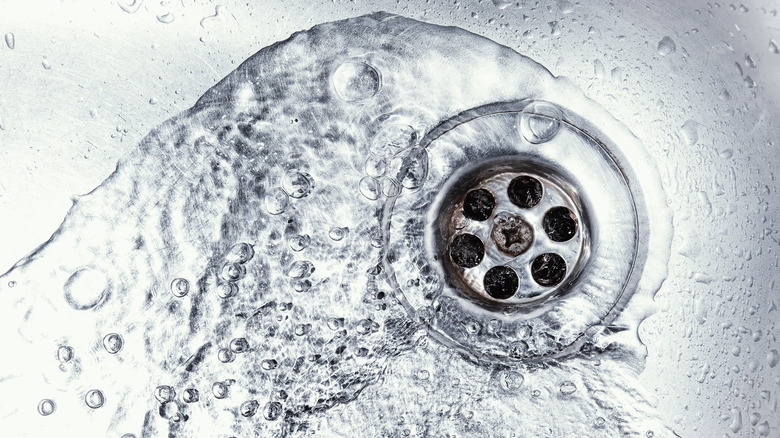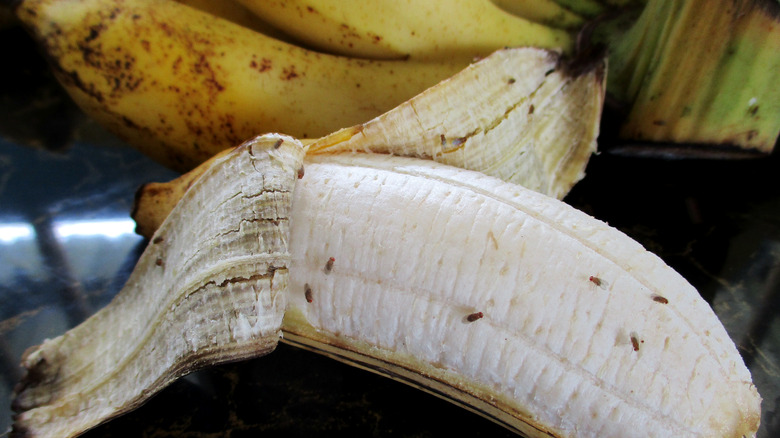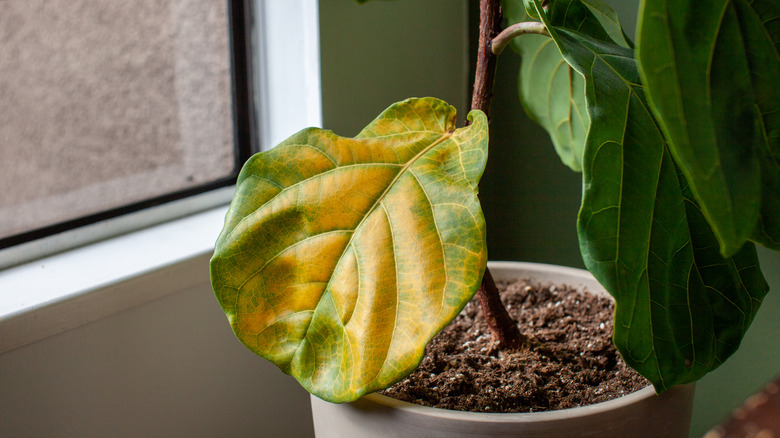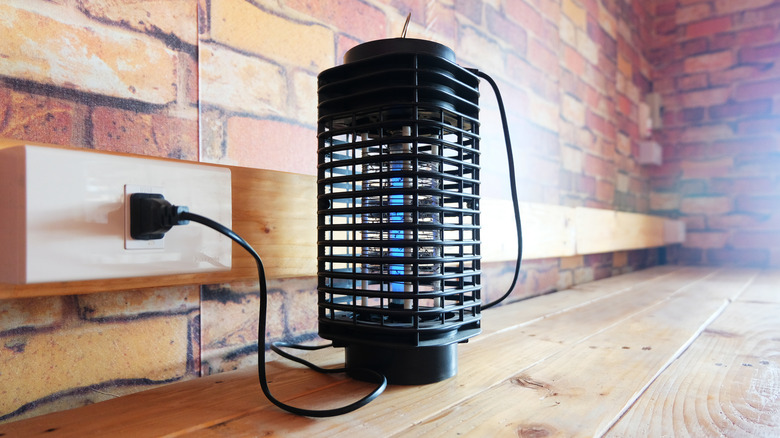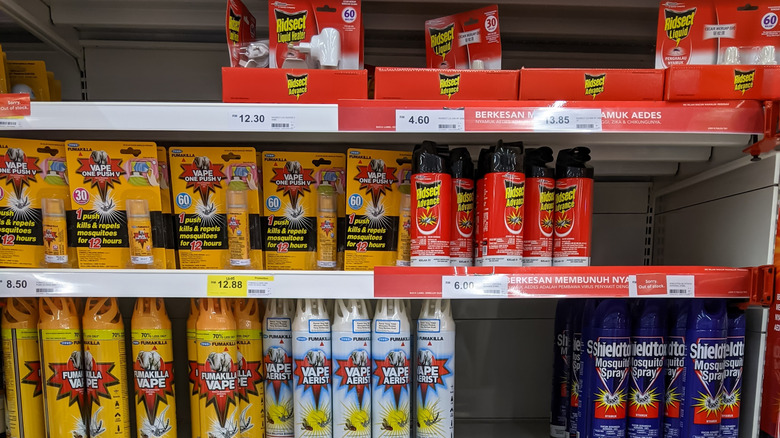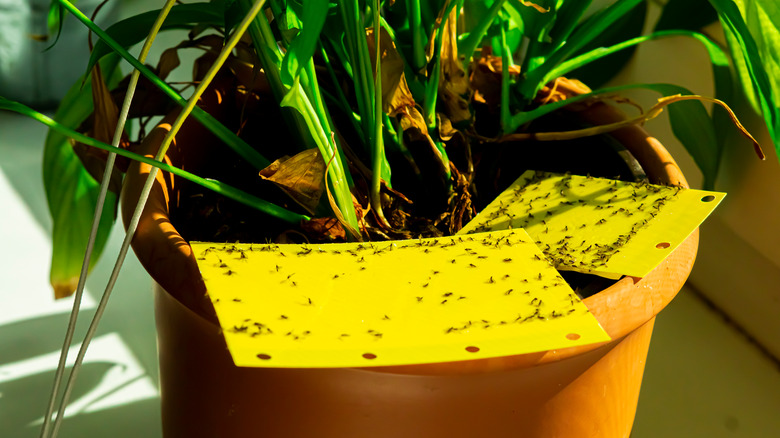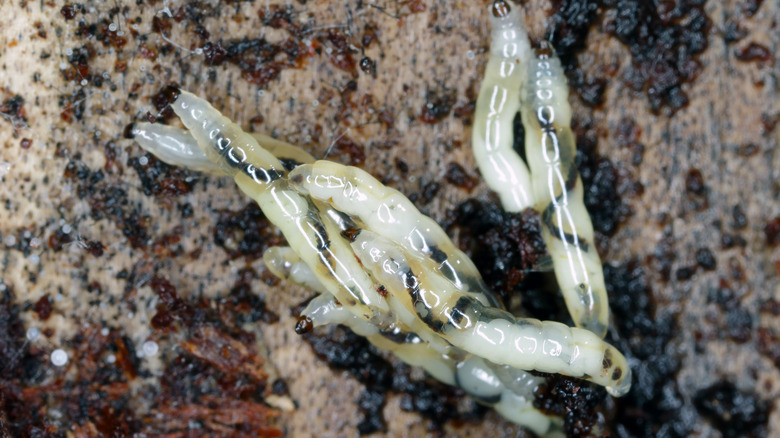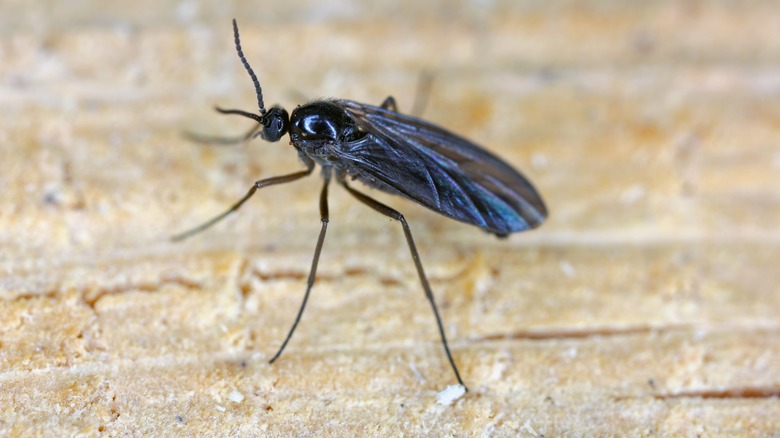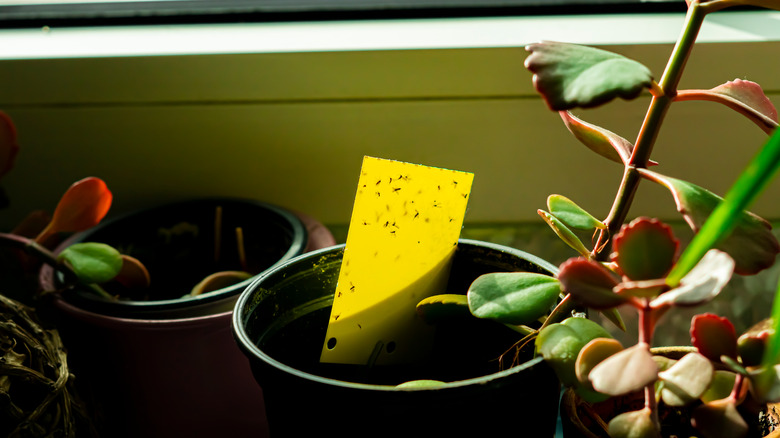13 Best Ways To Get Rid Of Gnats
Gnats, fruit flies — no matter what you call them, we can all agree that they're gross and downright annoying when they take up residence in your house. Depending on the variety, they can be more attracted to certain rooms or items in the house, too. Some may congregate in your kitchen, while others will hover around your houseplants, or they may prefer to stay close to your drains. If you're especially unlucky, you might have them in every room of your house.
No matter where they are, we've rounded up the best ways to get rid of your pesky gnat problem. If your problem is bordering on an infestation, you may need to employ several of these methods all at once. Don't give up too quickly, though. As much as we'd all love to, it's virtually impossible to get rid of gnats overnight. These annoying pests are famous for their staying power, and they can be difficult to eliminate completely, so you'll need to be patient, per The Washington Post.
1. Make a trap with apple cider vinegar
Gnats can't resist the tangy, sweet smell of apple cider vinegar. It's the perfect ingredient to entice them, and as a bonus for you, it's affordable and easy to find at your local grocery or big box store. According to Country Living, you'll need just a few items to set up this trap.
Grab a small, shallow dish (a ramekin works great) and fill it with a one to one ratio of warm water and apple cider vinegar. Add a spoonful of sugar and stir thoroughly. Next, add several drops of dish soap. Set the dish in an area where you've seen lots of gnats, and wait for it to work its magic. They'll fly in to sample the sweet concoction, but they'll be trapped by the dish soap. You might be appalled and horrified when you see just how many end up in the dish. Keep the ingredients handy so you can refresh the mixture every few days.
2. Hang up fly paper
Affordable and effective, fly paper will catch any — you guessed it — flying insects and trap them on its sticky surface. Hang strips in high traffic areas where you've seen lots of gnats, then sit back and let them do the work. If you've never used fly paper, be forewarned that it's very sticky, so hang it with care. You don't want it anywhere that's within reach of small children or pets.
Another thing to keep in mind is that fly paper shouldn't be used outside, warns HGTV. Even though the gnats likely originated outside, you run a high risk of trapping other winged creatures, especially helpful pollinators like butterflies and bumblebees.
Instead, focus on hanging fly paper in your kitchen. Some good locations include above the trash can, near the sink, and above any produce that sits out on the counter. Furthermore, fly paper is one of the solutions that works well in tandem with another. So if you've set out your apple cider vinegar traps, go ahead and hang some fly strips nearby for a double whammy of protection.
3. Clean your drains
Have you noticed that your gnat problem seems to be originating from the drains in your house? If so, Country Living says you're probably dealing with drain flies, and they require a different method of treatment. Apple cider vinegar probably won't be strong enough, so Bob Vila suggests bringing in the heavy duty stuff: bleach.
Before you just grab the jug and dump it down the sink, you need to protect yourself properly. First, make sure you're wearing rubber gloves, have proper ventilation in the room, and put on a mask to protect yourself from the powerful fumes. Next, dilute the bleach; Bob Vila says 1/2 cup of bleach to 1 gallon of water is a good ratio. Pour it down the drain and let it sit for a while before you turn on the faucet. You'll want to continue this process until you no longer see the gnats in your kitchen or bathroom.
4. Lure gnats with rotted fruit
If you're about to toss the brown, squishy bananas sitting on your counter, don't get rid of them just yet. It may seem counterintuitive to use something that attracted the gnats to begin with, but it actually makes sense — you've already got everything on hand and you know the gnats want it, so it's a win-win!
Grab the rotting bananas (or any fruit you have on hand that's starting to turn) and place them in a big bowl, instructs Popular Mechanics. Mash them up, and then cover the top of the bowl with plastic wrap. Secure it, and then poke small holes across the top (a toothpick works great for this). The gnats will eagerly fly into the trap in pursuit of the rotting fruit, but they won't be able to figure out how to escape. If you want to bolster the trap even further, hang some fly strips above it to catch any gnats that might manage to escape through the plastic wrap.
5. Don't overwater houseplants
While it's understandable to want your houseplants to thrive and grow, there's a fine line between watering and overwatering. If you water too much, you're likely to see gnats around your plants because they're drawn to the decomposing organic material in the soil, says Better Homes & Gardens. The two are connected because too much moisture speeds up the decomposition process, so it creates the perfect, welcoming environment for gnats. While you can't backtrack once the damage is done, you can treat the current gnat problem and be more aware of your watering habits going forward.
Besides using some of the methods we've already listed above, there are sticky strips that are specially designed for usage around houseplants. This is an effective, low cost method but be forewarned — you'll likely need to replace the strips frequently until the problem is under control. Better Homes & Gardens suggests placing the sticking strips directly in the soil of the houseplant (just watch out for its leaves so you don't damage them), or you can hang them overhead. When you're buying the sticky strips, look for ones that are non-toxic and double-sided, then let them get to work.
6. Buy a bug zapper
Bug zappers aren't just for outdoor use and catching menaces like horse flies or mosquitoes. They can also be an effective tool in your fight against gnats in the house. A quick search on Amazon shows a plethora of different models, sizes, and price ranges, so you can find one that's perfect for your needs. Zapper technology has come a long way from the large, loud options from years ago. Plus, the new models are much safer and specifically designed for indoor use with compact sizes, UV light, and glue boards instead of electric zaps, according to Country Living.
Once you purchase your bug zapper, place it in the highest traffic area for gnats, such as by the trashcan or near any produce on the kitchen counter. You can add a small dish of the apple cider vinegar mixture near the zapper to serve as a lure and guarantee maximum effectiveness.
7. Make a candle trap
Although this trick isn't as widely-known, that doesn't make it any less useful. What's even better is that you've likely got everything you need around the house, so you won't have to buy anything special or expensive for this trap. According to Popular Mechanics, this method is particularly effective at night.
You'll need one or two tall, taper-style candles and a candle holder for each of them. Next, fill a wide but shallow dish with water (a disposable pie pan works well). Place the candle holders into the water, light the candles, turn off any overhead lights, and let the flickering flame do all the work.
What's this trap going to do, exactly? Popular Mechanics explains that the gnats will be attracted to the flame, so they'll likely fly into it and burn. Even if they avoid incineration, there's a good chance they'll drop into the water below and drown. For safety reasons, this is one trap you'll want to keep far out of reach of children or pets.
8. Spray insecticide
If you're not having much luck with the homemade remedies and you're desperate to solve your gnat problem, you may need to turn to a more potent remedy like insecticide. You can either apply it yourself or hire a pest control company to come to your home, especially if the problem is severe.
When purchasing an insecticide, it's especially important to read the label carefully and use extreme caution if you have children and/or pets in the home. If you're bringing in the big guns, you certainly don't want to be spraying their chemicals willy nilly all over the produce in your kitchen.
You can find an appropriate insecticide at your local home improvement or big box store. There are varieties specifically geared towards gnats and are formulated to be safer for use in the kitchen. It's important to note that you never want to mix insecticides by using several kinds all at once. Choose one brand's formula and stick to it. If it doesn't work, give your home plenty of time to air out before you consider spraying a new insecticide.
9. Trap gnats with red wine
Have you ever noticed when enjoying your Merlot outside, you must constantly fight off the gnats and other insects? There's a reason for the attraction. Koffee Kompanions writes that most insects are attracted to odors, especially the odors of fermented fruit. Your bottle of red wine, chock full of fermented red grapes and sugars, is like a beacon of light for a gnat and other bugs.
Here's the thing: you're smarter than a gnat. They want wine; you've got wine. Use it to your advantage and trap them. Grab your sweetest red, some chunks of fruit, tape, and scissors. Pour most of the wine out of the bottle, preferably into glasses for sharing. Leave between 1 to 2 inches of wine at the bottom of the bottle for your gnat trap. Next, add fruit to the bottle, and using a piece of paper, shape it into a cone, so the pointed end fits snuggly into the tip of the bottle, with the wide part of the cone hanging out. Tape the paper to keep it together and trim it if it's longer than 6 inches (via eHow). Let your new trap sit on a counter for several days, and you'll likely get rid of your gnat problem.
10. Use sticky cards in plant pots
If you've got houseplants, you likely have fungus gnats visiting often. The problem is, like an unwelcomed houseguest, they don't leave. As mentioned, gnats love moisture and potting soil. Many plants need constant water, so letting the soil dry out to avoid gnats isn't the solution. Instead, since they are drawn to the plants, you can use your houseplants to trap the gnats and get rid of your insect problem for good. The secret is sticky traps.
The sticky trap is a very simple concept, consisting of a sticky piece of plastic you put into the potting soil, and the gnats then stick to it and stay stuck, according to Keep Your Plants Alive. Besides being sticky, the traps are colored a bright yellow to draw the gnat's attention. Once a trap is full, you can throw it away and add a new one. They're an inexpensive, simple way to get rid of pesky fungus gnats.
11. Put pesticide in plant soil
Don't let the word "pesticide" scare you into thinking your plants will become unhealthy as you wage war with the gnats. Some pesticides aren't derived from chemicals, and there are some safe, natural concoctions you can use to eliminate the gnats and not affect the soil. Mix up the following soil protectors with ingredients you probably have at home.
Just Home Gardening recommends trying Neem oil mixed with liquid dish soap and water, then spraying the soil once a week for two to three weeks. Another natural method is diluted hydrogen peroxide (one part hydrogen peroxide and four parts water). You can simply water your plants as usual with this solution and kill the gnats while not harming the plants. Lastly, you can also try grabbing your cinnamon out of the spice cabinet and sprinkling a layer on top of the potting soil. It kills the fungus that the larvae dine on, and they end up starving to death. It all sounds unfriendly, but it works if you want the gnats gone and the plants left alone.
12. Watch out for larvae
To completely end the cycle of gnats in your home, you've got to get rid of more than just the gnat. You have to find their larvae as well. The University of California Agriculture & Natural Resources explains that fungus gnats have four life cycle stages: eggs, larvae, pupa, and adult. Getting to the larvae stage stops them from turning into flying, pesky gnats.
To stop larvae from feeding on the soil, you should avoid overwatering and let the top of the ground dry out in between watering so the larvae can't enjoy the moist soil they thrive on. To trap larvae, you can add some chunks of potatoes into the ground. The larvae are attracted to them and will feed on the potatoes. When you check on the vegetable, you'll not only see if your soil is infested with larvae, but you'll be able to dispose of the little buggers.
13. Use a DIY lemon juice spray
If you're looking for natural ways to keep pesky gnats away, take a lemon out of your fridge or from your fruit bowl. The citric acid found in lemons is very strong. The gnats are repelled by this high acidity, keeping them farther away and preventing them from being such a nuisance. Plus, the overwhelming smell of the fruit itself makes it an even stronger repellent.
To leverage the power of lemon juice, you can make a DIY spray by mixing it with water in a 1:1 ratio. Then, pour the solution into a spray bottle and apply it around entry points into your home, such as door frames and window sills, or anywhere else where the gnats are getting in. To get rid of gnats outside, consider planting some lemon thyme in your garden. The pests are also repelled by the pretty herb's scent.
So, why are there gnats in your home?
Why are these annoying little buggers in your house in the first place? Have you done something wrong or attracted them in some way? Don't worry — although you have a magnetic personality, you are likely not a magnet for gnats. According to Entomology at the University of Kentucky, gnats are attracted to light. That means as they swarm (usually at dusk) and see your home's lights, they naturally head that way. It's not hard to get in since they are so tiny. Windows, doors, or any cracks are an invitation.
Once inside, gnats, namely fungus gnats, go right to the houseplants, which are full of moisture and the organic material they love to feed on (via Orkin). They happily reside in your plants as the females lay eggs, quickly producing more gnats for your enjoyment (via Orkin). Although you'll sometimes notice tiny critters around your fresh fruits sitting on the counter, those are actually fruit flies, not gnats. They are often easily mistaken for gnats because of their tiny size.
There are nine types of gnats
Sorry — if you thought there was only one type of gnat, think again. There are nine types of these annoying pests for you to deal with. Home Stratosphere explains that the nine different gnats are fungus gnats, sewer gnats, midges, sand gnats, gnat bugs, buffalo gnats, gall gnats, Hessian fly, and eye gnats. The two you'll most commonly see in your home are fungus and sewer gnats. As mentioned, fungus gnats are quite common and live in your house plants or other organic matter. Sewer gnats, also called drain gnats or drain flies, swarm around drains and happily make a home in all the moisture from your sink or shower. As they reproduce, they can wreak havoc, causing clogs in your drains.
Although you may not see other gnats as often in your home, they do exist, and some are not welcome. The gall gnat, for example, leaves its larvae in the sap of plants, which can ruin their growth. If you still have a plant problem after getting rid of your fungus gnats, look out for the gall gnat. And they aren't alone in causing trouble. The Hessian fly can destroy millions of dollars worth of wheat fields every year by eating seeds. Yikes! Other gnats are harmless but downright annoying. Have you ever tried to enjoy having a picnic, only to go mad with tiny little gnats flying around your face? It was likely eye gnats. They prefer the open cavities of the face. They apparently don't care for picnics.
Wait, there's more ... sand flies and buffalo gnats aren't harmless and will bite you if given a chance. The buffalo gnat has been known to be deadly to some animals, but it's more of an uncomfortable bug bite for humans. The sand fly, however, can leave a nasty rash and a fever. Lastly, midges prefer swamps, so you're in luck if you aren't living near one. They look and behave like mosquitos, which sometimes makes for a not-so-fun evening out.
We've saved the best for last. The gnat bug is a quiet thing who prefers the woods, hiding under rocks and leaves. Consider the gnat bug your favorite. They just like to hang out and enjoy their short life of about four weeks.
How do you prevent gnats from invading again
Thankfully, gnats are harmless. They're just annoying. Still, annoying things aren't necessarily welcome in your home. Bug-proofing your house is the best way to avoid gnats and other pests. You can start by ensuring all exterior doors and windows have screens. Without screens, every time you open a door or window, the tiniest of bugs can sneak in without you even seeing them. Besides screens, Pests in the Home suggests you check the seals on every door to ensure they're airtight and fill any cracks around doors and windows where insects can squeeze in. Once you've attended to the doors and windows, check your home for moisture.
Are there any leaky pipes or standing water in the basement or outside of your home? If you answered yes, your house could be prone to gnats since they thrive on moisture. Get any plumbing issues checked out and repaired, then work on keeping your home and yard dry. In conclusion, insects, including gnats, will get into the house now and then; however, there are steps you can take to get rid of them and keep them from coming back.
